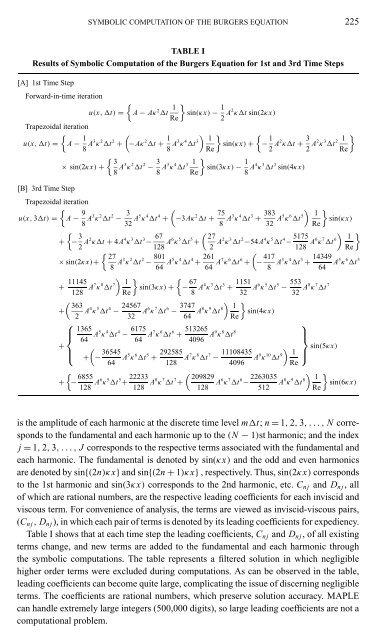A Preliminary Study of the Burgers Equation with Symbolic ...
A Preliminary Study of the Burgers Equation with Symbolic ...
A Preliminary Study of the Burgers Equation with Symbolic ...
Create successful ePaper yourself
Turn your PDF publications into a flip-book with our unique Google optimized e-Paper software.
SYMBOLIC COMPUTATION OF THE BURGERS EQUATION 225<br />
TABLE I<br />
Results <strong>of</strong> <strong>Symbolic</strong> Computation <strong>of</strong> <strong>the</strong> <strong>Burgers</strong> <strong>Equation</strong> for 1st and 3rd Time Steps<br />
[A] 1st Time Step<br />
Forward-in-time iteration<br />
<br />
A− Aκ2t 1<br />
<br />
sin(κx) −<br />
Re<br />
1<br />
2 A2κt sin(2κx)<br />
u(x,t)=<br />
Trapezoidal iteration<br />
<br />
u(x,t)= A− 1<br />
8 A3κ 2 t 2 <br />
+ −Aκ 2 t + 1<br />
8 A3κ 4 t 3<br />
<br />
1<br />
Re<br />
× sin(2κx) +<br />
<br />
3<br />
8 A3κ 2 t 2 − 3<br />
8 A3κ 4 3 1<br />
t<br />
Re<br />
<br />
sin(κx) + − 1<br />
2 A2κt + 3<br />
2 A2κ 3 <br />
2 1<br />
t<br />
Re<br />
<br />
sin(3κx) − 1<br />
8 A4 κ 3 t 3 sin(4κx)<br />
[B] 3rd Time Step<br />
Trapezoidal iteration<br />
<br />
u(x, 3t) = A − 9<br />
8 A3κ 2 t 2 − 3<br />
32 A5κ 4 t 4 <br />
+ −3Aκ 2 t + 75<br />
8 A3κ 4 t 3 + 383<br />
32 A5κ 6 t 5<br />
<br />
1<br />
sin(κx)<br />
Re<br />
<br />
+ − 3<br />
2 A2κt + 4A 4 κ 3 t 3 − 67<br />
128 A6κ 5 t 5 <br />
27<br />
+<br />
2 A2κ 3 t 2 −54A 4 κ 5 t 4 − 5175<br />
128 A6κ 7 t 6<br />
<br />
1<br />
Re<br />
<br />
27<br />
× sin(2κx)+<br />
8 A3κ 2 t 2 − 801<br />
64 A5κ 4 t 4 + 261<br />
64 A7κ 6 t 6 <br />
+ − 417<br />
8 A3κ 4 t 3 + 14349<br />
64 A5κ 6 t 5<br />
+ 11145<br />
128 A7κ 8 t 7<br />
<br />
1<br />
sin(3κx) + −<br />
Re<br />
67<br />
8 A4κ 3 t 3 + 1151<br />
32 A6κ 5 t 5 − 553<br />
32 A8κ 7 t 7<br />
<br />
363<br />
+<br />
2 A4κ 5 t 4 − 24567<br />
32 A6κ 7 t 6 − 3747<br />
64 A8κ 9 t 8<br />
<br />
1<br />
sin(4κx)<br />
Re<br />
⎧<br />
⎪⎨<br />
1365<br />
64<br />
+<br />
⎪⎩<br />
A5κ 4 t 4 − 6175<br />
64 A7κ 6 t 6 + 513265<br />
4096 A9κ 8 t 8<br />
<br />
+ − 36545<br />
64 A5κ 6 t 5 + 292585<br />
128 A7κ 8 t 7 − 11108435<br />
A<br />
4096<br />
9 κ 10 t 9<br />
⎫<br />
⎪⎬<br />
sin(5κx)<br />
1 ⎪⎭<br />
Re<br />
<br />
+ − 6855<br />
128 A6κ 5 t 5 + 22233<br />
128 A8κ 7 t 7 <br />
209829<br />
+<br />
128 A6κ 7 t 6 − 2263035<br />
A<br />
512<br />
8 κ 9 t 8<br />
<br />
1<br />
sin(6κx)<br />
Re<br />
is <strong>the</strong> amplitude <strong>of</strong> each harmonic at <strong>the</strong> discrete time level mt; n = 1, 2, 3,...,N corresponds<br />
to <strong>the</strong> fundamental and each harmonic up to <strong>the</strong> (N − 1)st harmonic; and <strong>the</strong> index<br />
j = 1, 2, 3,...,J corresponds to <strong>the</strong> respective terms associated <strong>with</strong> <strong>the</strong> fundamental and<br />
each harmonic. The fundamental is denoted by sin(κx) and <strong>the</strong> odd and even harmonics<br />
are denoted by sin{(2n)κx} and sin{(2n + 1)κx} , respectively. Thus, sin(2κx) corresponds<br />
to <strong>the</strong> 1st harmonic and sin(3κx) corresponds to <strong>the</strong> 2nd harmonic, etc. Cnj and Dnj, all<br />
<strong>of</strong> which are rational numbers, are <strong>the</strong> respective leading coefficients for each inviscid and<br />
viscous term. For convenience <strong>of</strong> analysis, <strong>the</strong> terms are viewed as inviscid-viscous pairs,<br />
(Cnj, Dnj), in which each pair <strong>of</strong> terms is denoted by its leading coefficients for expediency.<br />
Table I shows that at each time step <strong>the</strong> leading coefficients, Cnj and Dnj, <strong>of</strong> all existing<br />
terms change, and new terms are added to <strong>the</strong> fundamental and each harmonic through<br />
<strong>the</strong> symbolic computations. The table represents a filtered solution in which negligible<br />
higher order terms were excluded during computations. As can be observed in <strong>the</strong> table,<br />
leading coefficients can become quite large, complicating <strong>the</strong> issue <strong>of</strong> discerning negligible<br />
terms. The coefficients are rational numbers, which preserve solution accuracy. MAPLE<br />
can handle extremely large integers (500,000 digits), so large leading coefficients are not a<br />
computational problem.














